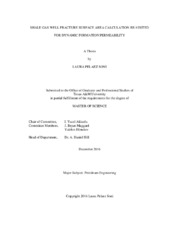| dc.description.abstract | Shale gas wells exhibit long-term transient linear flow, which is in most cases the only flow regime available for analysis in these wells. Several methods have been developed to analyze transient linear flow in shale gas wells by adjusting solutions for tight gas wells, assuming both homogeneous and dual-porosity reservoirs. These analytical models use the slope of the inverse of rate vs. square root of time plot to calculate reservoir parameters such as the flow parameter, fracture half-length and total fracture surface area. However, the derivation of these methods neglects the stress dependent nature of formation permeability and the effects of molecular transport mechanisms on gas production.
In this work, a synthetic data simulation model was used to forecast gas production from a shale reservoir with dynamic matrix permeability. The production data was analyzed using conventional rate transient analysis (RTA) to calculate the value of total fracture surface area. Using a dynamic permeability model with mechanical effects, results show that the error in total fracture surface area caused by the assumption of constant permeability in the reservoir ranges from 9% to 28%. When molecular transport mechanisms are included in the dynamic permeability model, the range of the error in surface area becomes 1% to 323%. Sensitivity analysis shows that stress-dependent parameters, which affect matrix permeability in the area away from the fractures, have the highest impact on the surface area error.
A modified RTA model is presented in this work which accounts for dynamic permeability in the shale matrix by introducing pseudo-pressure and pseudo-time definitions. Results show that the model is able to retrieve the correct value of total fracture surface area from the production data. Since the calculation is independent of time, total fracture surface area can be calculated early in the life of the well to evaluate the effectiveness of the hydraulic fracturing job. | en |


